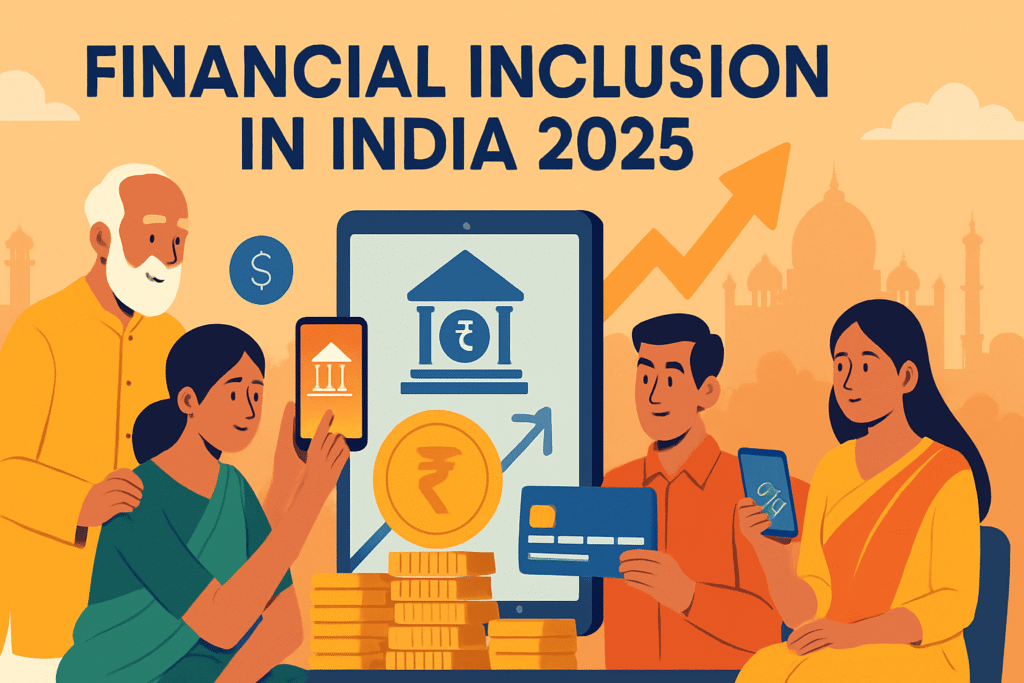Financial Inclusion in India 2025 shows major growth with schemes like Jan Dhan, UPI, and APY driving access, literacy, and digital empowerment.
India’s push toward a financially empowered nation is showing measurable success, with banking services now reaching even the most remote corners of the country. What was once a luxury for a few—bank accounts, credit access, insurance, and pensions—is becoming accessible to all. According to the Reserve Bank of India, the Financial Inclusion Index (FI-Index) for the year ending March 2025 has climbed to 67.0, up from 64.2 in March 2024. Launched in 2021, the FI-Index captures progress across banking, investment, insurance, postal, and pension sectors. The latest figures show growth across all sub-indices—Access, Usage, and Quality—indicating stronger financial literacy and better use of financial services.
What is Financial Inclusion and Why It Matters
Financial Inclusion means providing affordable and accessible financial products and services to all individuals and businesses in a sustainable and responsible manner. It supports entrepreneurship, empowers women, helps manage risks, and boosts economic productivity.
Recognised globally, financial inclusion is a key enabler for 7 out of the 17 UN Sustainable Development Goals. The World Bank’s Global Findex 2025 reports that account ownership in India has reached 89% since 2011, showing notable improvements in financial activity among adults.
Understanding the Financial Inclusion Index
To monitor equitable financial access, the RBI introduced the FI-Index, a composite measure based on 97 indicators. The index scales from 0 (no inclusion) to 100 (complete inclusion) and includes three sub-indices:
- Access (35%): Measures availability of banking and digital infrastructure like PoS terminals, post offices, PPI issuers, etc.
- Usage (45%): Captures demand-side usage of financial services like UPI transactions, savings, credit, and DBT transfers.
- Quality (20%): Reflects financial literacy, consumer protection, and reduction in service inequality.
The index reflects a comprehensive view of how people use financial tools and how well they are protected and educated about them.
Strategic Framework for Inclusion
To achieve universal banking access and reduce poverty, India introduced the National Strategy for Financial Inclusion (2019–2024) and the National Strategy for Financial Education (2020–2025).
- NSFI Goals include universal access within 5 km radius, digital onboarding, access to basic financial services, and grievance redressal.
- NSFE’s 5-C Approach focuses on Content, Capacity, Community, Communication, and Collaboration across all stakeholders, from banks to educational institutions.
Major Government Initiatives Driving Financial Inclusion
- Pradhan Mantri Jan Dhan Yojana (PMJDY): A landmark scheme offering zero-balance accounts, RuPay cards, insurance, and overdraft facilities. As of August 2025, over 55.98 crore beneficiaries have joined, 55% of them women.
- Pradhan Mantri Suraksha Bima Yojana (PMSBY): Offers accident insurance at ₹20 per annum. Over 50.54 crore enrolled by March 2025.
- Pradhan Mantri Jeevan Jyoti Bima Yojana (PMJJBY): Life insurance at ₹436 annual premium. Covered over 23 crore citizens, with ₹2 lakh to nominee upon death.
- Atal Pension Yojana (APY): Pension for unorganised sector workers. As of April 2025, has 7.65 crore subscribers and 48% women participation.
- Pradhan Mantri MUDRA Yojana (PMMY): Loans up to ₹20 lakh for small enterprises. Over ₹35.13 lakh crore sanctioned in 53.85 crore loans. Aimed at women, minorities, and first-time entrepreneurs.
- Stand Up India Scheme (SUI): Loans for SC/ST and women to start greenfield enterprises. ₹61,020 crore sanctioned as of March 2025.
- Unified Payments Interface (UPI): Enabled 18.39 billion transactions worth ₹24.03 lakh crore in June 2025 alone. UPI now handles 85% of all digital payments in India and nearly 50% globally.
- Mahila Sammriddhi Yojana (MSY): Empowers women through training, SHGs, and loans up to ₹1.4 lakh. ₹72,859 lakhs disbursed as of March 2025.
- Kisan Credit Card (KCC): Affordable credit for farmers. ₹10.05 lakh crore disbursed by Dec 2024, benefiting 7.72 crore farmers.
Nationwide Saturation Campaign
To ensure no citizen is left behind, the Ministry of Finance launched a 3-month Financial Inclusion Saturation Campaign from July to September 2025. The focus is on re-KYC, new bank account openings, insurance enrollments, and awareness about fraud prevention and grievance redressal.
In July 2025 alone:
- 99,753 camps were organised
- 6.65 lakh Jan Dhan accounts opened
- Over 10 lakh accounts re-verified for KYC
Conclusion
India’s journey toward complete financial inclusion is marked by measurable progress and strong intent. The rise in the FI-Index reflects not only the success of government schemes like PMJDY and UPI but also the commitment to economic equity across all sectors and demographics. As financial inclusion deepens, so does the promise of a resilient, inclusive, and digitally empowered India—where no citizen is left behind.
Read Also :-
Aadhaar Seeding and Digital Reforms in PM-KISAN Scheme: Empowering Farmers with Direct Support

